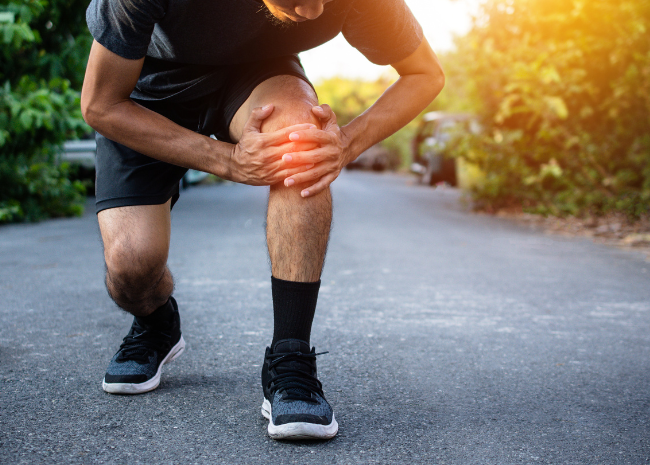Knee Pain — The Jackson Clinics Physical Therapy
Understanding Knee Pain
Knee pain can take a toll on your daily life, no matter your age or how active you are.
Whether you’re an athlete, active adult, or tend to be more sedentary, understanding what causes your knee pain, its symptoms, and treatment options can make all the difference.
Here’s what you need to know to get relief and improve your quality of life.
Let’s Discuss:
- What causes knee pain
- Symptoms of knee pain
- Diagnosing knee pain
- Treatment options for knee pain
- Preventing knee pain
- When to seek medical help


What Causes Knee Pain?
Knee pain can stem from a variety of causes, including injuries and medical conditions.
Two common sources of knee pain are injuries and arthritis.
– Injury-Related Knee Pain:
Accidents or sports activities often lead to injuries such as ligament tears, meniscus tears, or tendonitis.
These injuries can cause pain, swelling, and reduced mobility. If you’ve hurt your knee, seeking prompt care and starting rehabilitation right away is key to a strong recovery.
– Arthritis-Related Knee Pain:
Osteoarthritis is the most common form of arthritis and happens when the cartilage in your knee wears down over time.
This leads to pain, stiffness, and inflammation. Rheumatoid arthritis, an autoimmune disease, can also contribute to chronic knee pain.
Common Symptoms of Knee Pain
Knee pain often comes with additional symptoms that can help pinpoint the cause and guide treatment.
Some common signs to watch for include:
- Pain Levels & Locations: You might feel a dull ache or sharp, stabbing pain in the front, back, or sides of your knee.
- Swelling & Stiffness: If your knee looks swollen or feels warm to the touch, it could be a sign of inflammation. Morning stiffness or tightness after sitting for long periods is also common.
- Walking or Bearing Weight Issues: Knee pain can make it tough to walk or stand, leading you to favor one leg over the other.
If these symptoms sound familiar, it’s time to reach out to a healthcare professional for an evaluation.
Whether it’s injury or arthritis-related, seeking help early can lead to more effective treatment and faster recovery.
Diagnosing Knee Pain
Getting an accurate diagnosis is crucial to understanding and treating your knee pain effectively.
Your doctor may use several methods to identify the cause:
- Physical Examination: Your doctor will check for swelling, range of motion, and knee stability.
- Medical History: They will review past injuries, surgeries, and medical conditions that could be contributing to the pain.
- Imaging Tests: X-rays or MRIs may be needed to provide a detailed view of:
- Fractures or bone abnormalities
- Cartilage damage
- Ligament and tendon issues
Treatment Options for Knee Pain
When knee pain strikes, the right treatment can help you regain your quality of life. Depending on the severity of your pain, there are a variety of treatment options.
- Non-Surgical Options: For milder cases, rest, ice, compression, and elevation (the RICE method) can help reduce inflammation. Over-the-counter pain relievers or anti-inflammatory medications may also help. Sometimes, assistive devices like knee braces or crutches are recommended to support the knee.
- Physical Therapy: Physical therapy is a powerful tool for managing knee pain. A therapist will guide you through exercises designed to strengthen the muscles around your knee, improve flexibility, and align the joint. They may also use treatments like ultrasound, electrical stimulation, or hot/cold therapy to further relieve pain.
- Surgical Options: If non-surgical treatments don’t provide enough relief, surgery may be an option. Arthroscopy, which uses a small camera to diagnose and treat knee issues, and knee replacement surgery for severe arthritis are two possibilities.
Preventing Knee Pain
Prevention is the best way to keep your knees healthy. Whether you’re an athlete or enjoy regular activities, taking care of your knees can reduce the risk of pain or injury.
Here’s how:
- Maintain a Healthy Weight: Extra pounds add stress to your knees. Keeping your weight in check can reduce that strain and lower the risk of knee pain.
- Wear Proper Gear: If you’re active, be sure to wear the right knee protection—knee pads, braces, or supportive shoes can prevent injury and pain.
- Strengthen & Stretch: Strong muscles around the knee offer stability, and regular stretches keep your muscles balanced. Exercises like squats, lunges, and hamstring curls can help.
When Should You Seek Medical Help?
Knowing when to see a doctor is important. While some knee pain can be managed at home, other signs may indicate it’s time to see a healthcare professional.
Seek immediate medical attention if you experience:
- Significant swelling or redness
- Difficulty bearing weight or walking
- Intense pain that doesn’t go away with rest
If your knee pain persists or worsens over several days, limits your movement, or keeps coming back, it’s a good idea to schedule an evaluation.
Is Physical Therapy Right for You?
If you’re dealing with knee pain, you may wonder whether physical therapy is the right solution.
Physical therapy can be highly effective for many types of knee pain, including injuries, arthritis, or after surgery. It offers a personalized approach to reducing pain, improving mobility, and strengthening the muscles around your knee for long-term relief.
Physical therapy might be right for you if:
- You have an injury: Physical therapy can help restore strength and flexibility after knee injuries like ligament tears, tendonitis, or meniscus damage.
- You want to avoid surgery: For many people with knee pain, physical therapy can be a non-invasive way to improve symptoms and delay or avoid surgical interventions.
- You’re recovering from surgery: After knee surgery, such as a knee replacement or arthroscopy, physical therapy is key to regaining movement and returning to your normal activities.
- You suffer from arthritis: Physical therapy can ease the stiffness and pain associated with osteoarthritis and rheumatoid arthritis, helping you stay active and mobile.
- Your knee pain interferes with daily life: If knee pain is preventing you from walking, exercising, or enjoying life as usual, physical therapy can provide strategies to help you regain control and alleviate discomfort.
Consulting a physical therapist can help determine whether this approach is right for you.
By assessing your specific condition, they can create a customized treatment plan to help you achieve lasting relief and get back to doing what you love.









